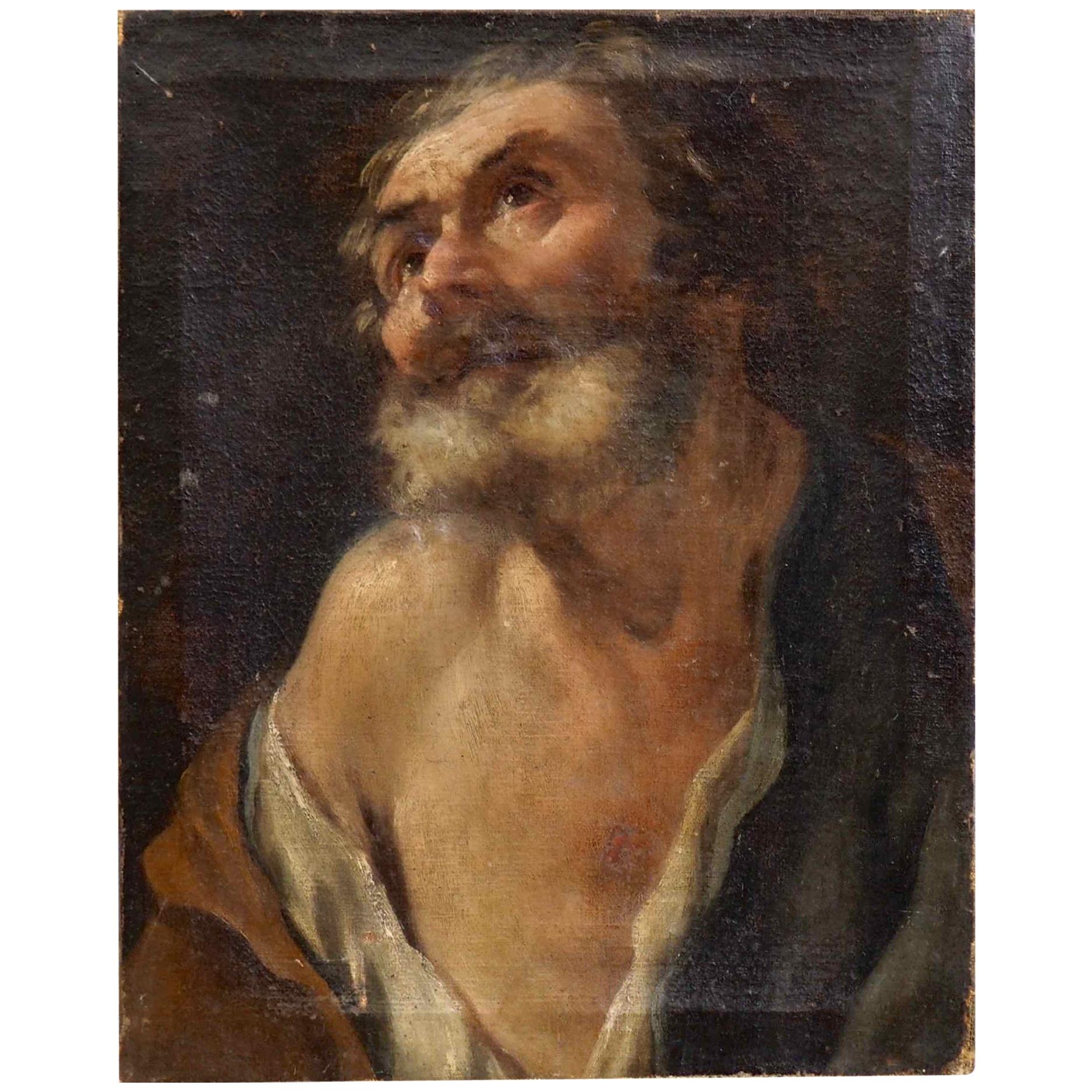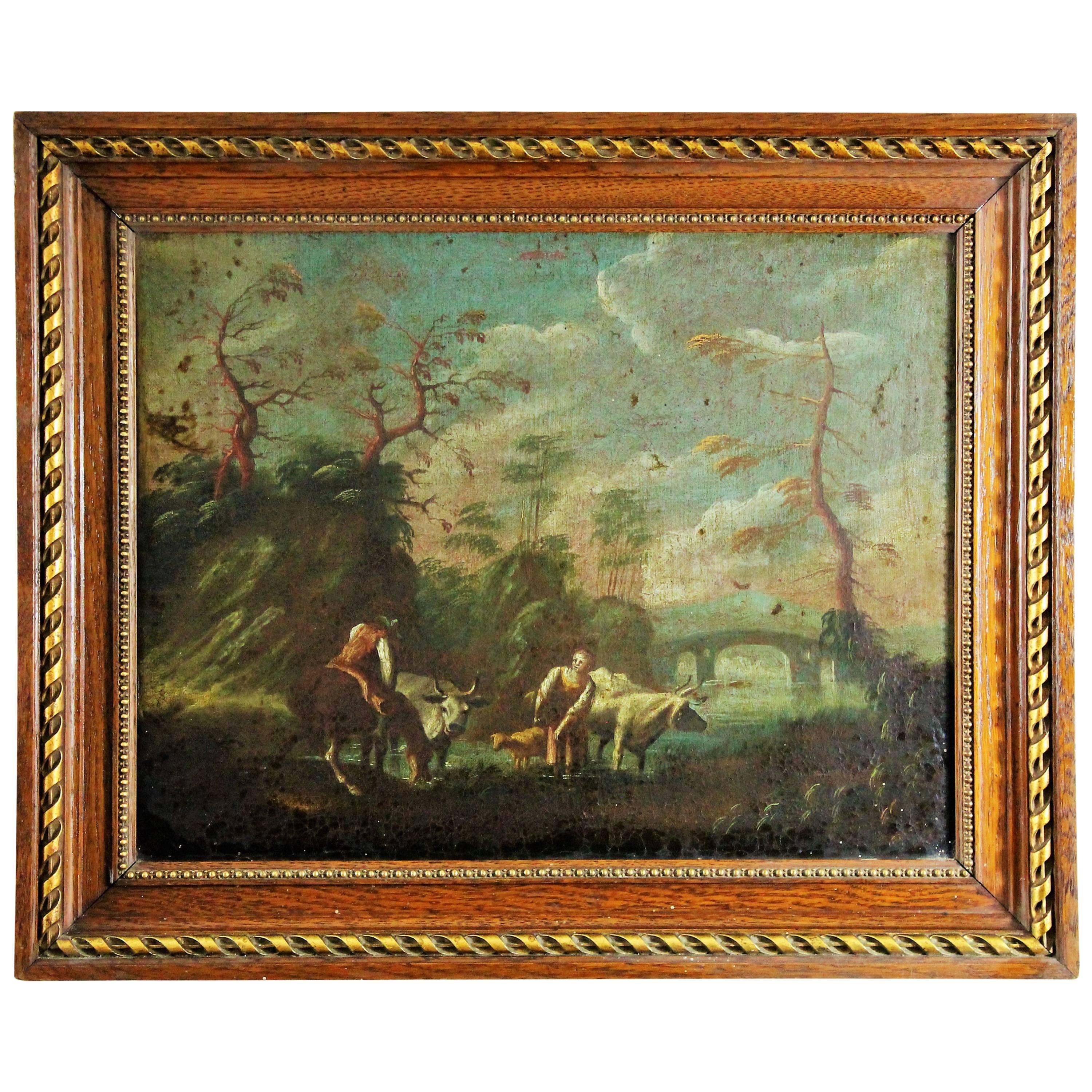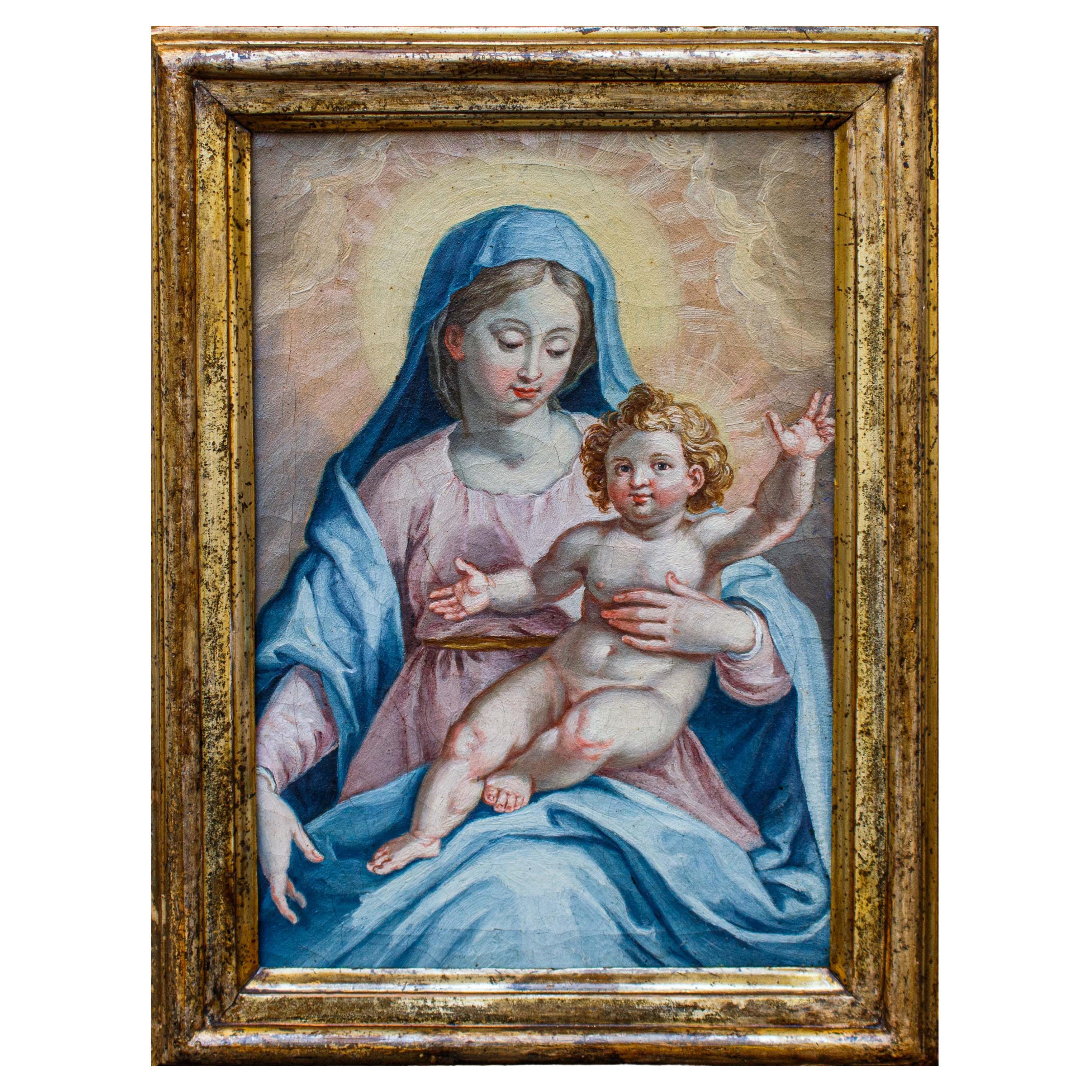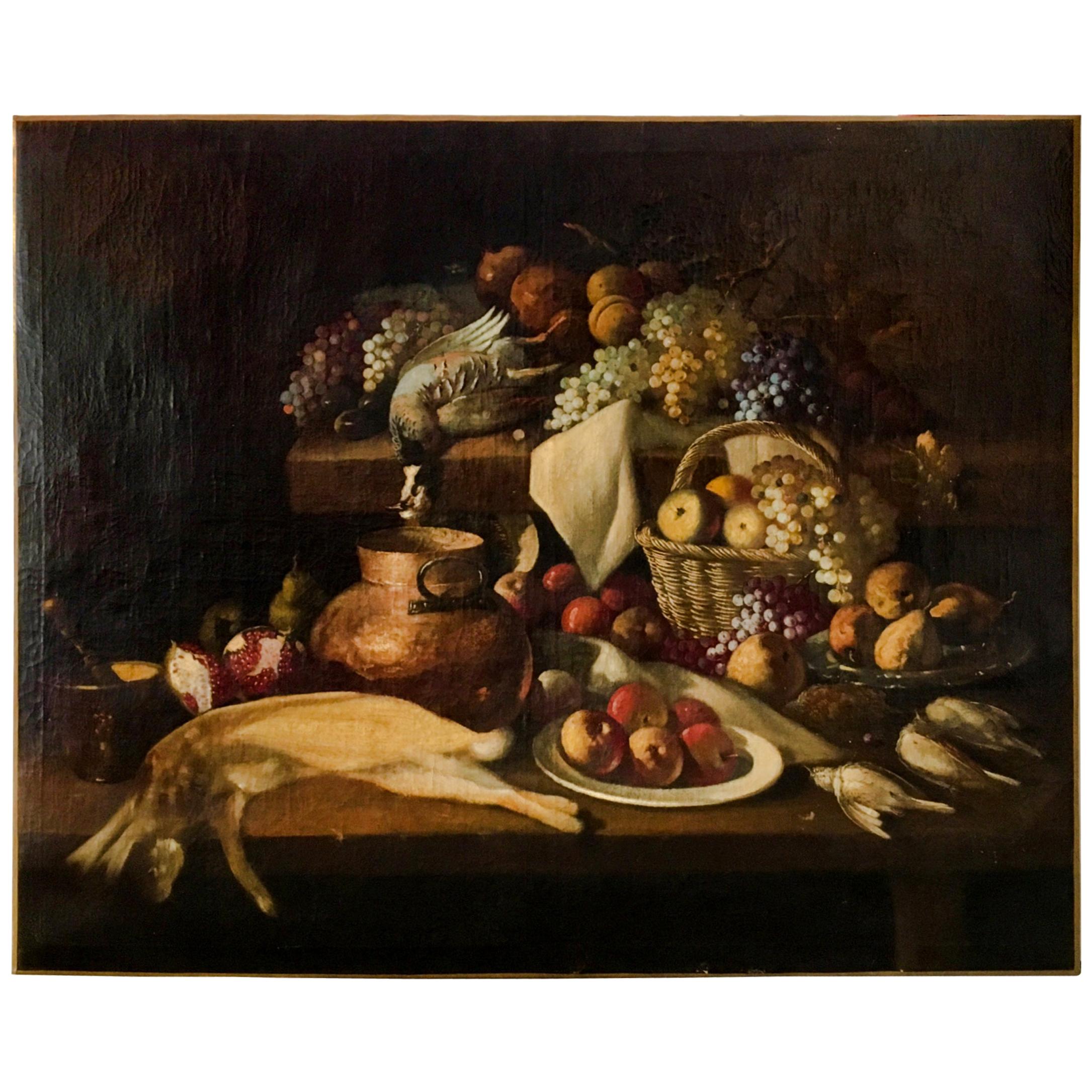Items Similar to Italian 17th Century Oil on Canvas Head of Christ Crowned with Thorns, Mignard
Want more images or videos?
Request additional images or videos from the seller
1 of 10
Italian 17th Century Oil on Canvas Head of Christ Crowned with Thorns, Mignard
About the Item
A very fine Italian 17th century oval oil on canvas "Head of Christ Crowned with Thorns" Circle of Pierre Mignard (French, 1612-1695) within its original gilt wood and gesso carved frame. A crown of thorns was placed on Christ’s head in the lead up to his crucifixion, while Roman soldiers mockingly declared him ‘King of the Jews’ (Matthew 27: 29). This detailed portrayal of Christ’s face convincingly conveys his anguish in the aftermath of this torment, circa: 1670-1690.
Provenance: Anonymous sale, Paris, Hotel Drouot, 26 March 2003, lot 55 (as Attributed to Nicolas Mignard).
Measures: Canvas Height: 15 1/2 inches (39.4 cm)
Canvas Width: 12 5/8 inches (32 cm)
Frame Height: 25 1/4 inches (64.1 cm)
Frame Width: 20 1/4 inches (51.4 cm)
Frame Depth: 3 1/4 inches (8.3 cm)
The Head of Christ or 'Ecce Homo' is one of the most frequently represented subjects in seventeenth-century painting. Following the Counter-Reformation (the self-imposed disciplining of the Catholic Church to ‘counter’ the successes of the Protestant Reformation), portrayals of Christ’s suffering became increasingly popular, as such images provoked empathy and devotion in viewers. One of the functions of seventeenth-century art was to instill an understanding of human experience, close-up images of the suffering Christ did just that.
Pierre Mignard or Pierre Mignard I (17 November 1612 – 30 May 1695), called "Mignard le Romain" to distinguish him from his brother Nicolas Mignard, was a French painter known for his religious and mythological scenes and portraits. He was a near-contemporary of the Premier Peintre du Roi Charles Le Brun with whom he engaged in a bitter, life-long rivalry.
Life
Pierre Mignard was born at Troyes, France in 1612 as the son of Pierre and Marie Gallois. He came from a family of artisans. He was the younger brother of Nicolas, who became a painter and etcher who was mainly active in Avignon and was known as Mignard d'Avignon. Nicolas had two sons, Paul who became a painter and etcher and Pierre who became a painter and architect. To distinguish his nephew Pierre from his uncle, the nephew was called "Pierre II" or "Le Chevalier".
Pierre Mignard trained in Bourges with the Mannerist painter Jean Boucher. He later spent time making copies of the Mannerist works in the château of Fontainebleau. He then studied for a period in the studio of Simon Vouet. Mignard left for Rome in 1635 where he would stay about 22 years. It is because of his long residence in Rome that he got the nickname 'Mignard le Romaine'.
In Rome he painted religious commissions. He was particularly known for his many images of the Madonna and Child. They were so popular that they were referred to as "Mignardises." He also painted altarpieces. Compatriot Nicolas Poussin hired Mignard to make copies of his works. He was also active as a reproductive engraver making copies after Annibale Carracci. Mignard also developed his lifelong interest in portraiture at this time, and he painted portraits of subsequent popes, cardinals, and prominent members of the Italian nobility. He also travelled to Northern Italy where he visited Bologna, Parma, Mantua, Florence and Venice.
His reputation was such that he was summoned to Paris in 1657, probably by Cardinal Mazarin. He travelled back via Avignon where his brother Nicolas worked. Here he met the dramatist Molière, who became a close friend and of whom he painted several portraits. In Paris he became a popular portrait painter. He found favor with king Louis XIV who sat for many portraits. Mignard became a rival of the leading French painter of that time and first painter to the King, Charles Le Brun. He declined to enter the academy of which Le Brun was the head. Mignard also opposed the authority of the academy. His brother Nicolas and his nephew Paul, who was his pupil, chose the side of Le Brun against Pierre, which led to a break in the relationship.
With the death of Le Brun in 1690, the situation changed. Mignard succeeded to all the posts held by his opponent. He died in 1695 at Paris as he was about to begin work on the cupola of Les Invalides.
Work
Mignard was mainly active as a portrait painter. He also produced mythological and religious scenes.
Soon after his return to Paris, Mignard was able to attract the patronage of important personalities who commissioned portraits of him. His sitters included Turenne, Molière, Bossuet, Maintenon (in the Louvre), La Vallière, Sévigné, Montespan, Descartes (in Castle Howard). He was thus one of the most successful portrait painters of his time although according to some art historians also the most boring one.
Many of compositions were engraved by Gérard Audran, Pieter van Schuppen, Robert Nanteuil, Gérard Edelinck, Antoine Masson, François de Poilly and others.
There is a good selection of works by Pierre, Nicolas, and Pierre II in Avignon at the Musée Calvet. The Courtauld Institute of Art (London), Harvard University Art Museums, the Hermitage Museum, the Honolulu Museum of Art, Kunst Indeks Danmark, the Louvre, Musée d'Art et d'Histoire (Geneva), Musée des Augustins (Toulouse, France), Musée Ingres (Montauban, France), Museo Lombardi (Parma, Italy), the Museum of Fine Arts, Houston, the National Gallery, London, the National Portrait Gallery, London, the North Carolina Museum of Art, the Portland Art Museum and Versailles are among the public collections holding works by Pierre Mignard.
- Similar to:(circle of) Pierre Mignard (Painter)
- Dimensions:Height: 25.25 in (64.14 cm)Width: 20.25 in (51.44 cm)Depth: 3.5 in (8.89 cm)
- Style:Baroque (Of the Period)
- Materials and Techniques:
- Place of Origin:
- Period:
- Date of Manufacture:circa 1670-1690
- Condition:Repaired: In paint touch ups. Relined. Additions or alterations made to the original: Canvas has been professionally relined. Wear consistent with age and use. Minor losses. Minor fading. A truly fantastic quality painting of Christ with its original 17th century gilt-wood carved frame. Overall condition is great, some minor touch-ups to canvas and some wear to frame gilt. Please view all images.
- Seller Location:Los Angeles, CA
- Reference Number:
About the Seller
5.0
Vetted Seller
These experienced sellers undergo a comprehensive evaluation by our team of in-house experts.
Established in 1982
1stDibs seller since 2016
114 sales on 1stDibs
Typical response time: <1 hour
- ShippingRetrieving quote...Ships From: Los Angeles, CA
- Return PolicyThis item cannot be returned.
More From This SellerView All
- After Fragonard French 19th Century Oil on Canvas Progress of Love-Lover CrownedBy (After) Jean-Honoré FragonardLocated in Los Angeles, CAA large French 19th century oil on canvas (laid down on a masonite) "Les progrès de l'amour dans le cœur d'une jeune fille" The Progress of Love: The Lover Crowned, after Jean-Honoré...Category
Antique 19th Century French Rococo Paintings
MaterialsMasonite, Gesso, Canvas, Giltwood
- Italian 18th Century Oil on Canvas "Madonna and Child" after Giovanni LanfrancoBy Giovanni LanfrancoLocated in Los Angeles, CAA very fine Italian 18th century oil on canvas "Madonna and Child" after Giovanni Lanfranco (Italian, 1582-1647). The young Virgin Mary attending to...Category
Antique 18th Century Italian Baroque Paintings
MaterialsCanvas, Giltwood
- 18th Century Oil on Canvas Mother & Child Attr Michael DahlBy Michael DahlLocated in Los Angeles, CAA very fine and large 18th century oil on canvas titled "Mother and Child" (Probably members of The Swedish Royal Family). Attributed to Michael Dahl (Swe...Category
Antique 18th Century Swedish Baroque Paintings
MaterialsGesso, Canvas, Wood
- Italian 19th Century Oil on Canvas "The Music Professor" Carlo SassiBy Carlo SassiLocated in Los Angeles, CAItalian 19th century oil on canvas titled "The Music Professor" depicting a mid-19th century music-room scene of an elder man, the music professor, holding his violin, hat and umbrel...Category
Antique 19th Century Italian Other Paintings
MaterialsGesso, Canvas, Wood
- Federico Mazzotta 'Italian, 1839-1897' a 19th Century Oil on Canvas Maiden & CowBy Federico MazzottaLocated in Los Angeles, CAFederico Mazzotta (Italian, 1839-1897) A fine Italian 19th century Oil on Canvas "A Maiden with her Calf", depicting a joyous peasant next to her cal...Category
Antique 19th Century Italian Country Paintings
MaterialsGesso, Canvas, Giltwood
- Federico Mazzotta 19th Century Oil on Canvas "Grandfather"By Federico MazzottaLocated in Los Angeles, CAFederico Mazzotta (Italian, 1839-1897) A Very Fine Italian 19th Century Oil on Canvas "Greeting Grandfather", depicting a joyous grandfather enjoying...Category
Antique 19th Century Italian Country Paintings
MaterialsCanvas, Giltwood
You May Also Like
- 17th Century Christ and the Samaritan Oil on Canvas Roman SchoolLocated in Milan, ITRoman school of the 17th century Landscape with bridge - Christ and the Samaritan woman at the well Oil on canvas, cm 42 x 59,5 - With frame, cm 54, 5 x 71 cm The small canvas portrays a broad view of the city surrounded by a bucolic and lush landscape, probably a reinterpretation of the Roman countryside or the Agro. The fulcrum of the canvas is the bridge consisting of several bays beyond which stands a village. In the distance the landscape made of green mountains opens into what looks like a lake crossed by boats. The landscape is animated by the human presence; not only small and fleeting figurines intent on walking along earthy paths but also the representation, in the foreground, of an Gospel episode, that of Christ and the Samaritan woman at the well. The landscape can be clearly traced back to a painter trained on the examples of the great seventeenth-century Roman baroque landscape that sees in the Lunette Aldobrandini by Annibale Carracci but also in Claude Lorrain, Nicolas Poussin and Gaspar Doghet are its greatest achievers. If in the past, therefore, the landscape was considered the scenic background on which to project the representation of divine or human characters, in the seventeenth century it became an autonomous and codified pictorial genre. With Carracci comes the so-called ideal landscape: a mental reconstruction of a peaceful and harmonious nature in which the dream of a perfect communion with man is realized. In the wake of Hannibal, as mentioned, during the seventeenth century the "classic" Roman landscape knows a long and happy season by artists such as Domenichino, and the French Claude Lorrain, Nicolas Poussin and Gaspar Dughet. Lorrain investigates the Roman countryside in all its aspects, studying the variations in the different hours of the day, the seasons or weather conditions, but always nourished by a sense of bucolic Virgilian. With Poussin the approach becomes intellectual elaboration and sophisticated rational construction. From the examples of the great masters, the Roman Baroque season, from the middle of the century, saw the flourishing of several personalities who, with shots, but also important personal reworkings, led to further spread the genre. Among the personalities that can be compared to the work in question we cannot fail to mention Crescenzio Onofri (1634-1714), defined by Salerno as the only true pupil of Dughet, who then spread in Florence the taste of the Baroque landscape influencing Tuscan painters such as Panfi and Peruzzini. His paintings are in various Roman collections; such as, for example, the landscapes from the Sacchetti Collection and today at the Pinacoteca Capitolina. and those in the Almagià collection in Rome, others in the Palazzo di Montecitorio, but the most conspicuous group is in the Galleria Doria. In comparison we can mention the two passages of the National Gallery in London, the landscape with a bridge over the Antiquarian Market but also the design of the National Gallery of Art in Washington. In the work you can also find the influences of the art of Giovanni Francesco Grimaldi...Category
Antique 17th Century Italian Paintings
MaterialsCanvas
- 17th Century Italian Flemish Oil on Canvas Painting of Adoration of the MagiLocated in North Miami, FL17th Century Italian Flemish oil on canvas painting depicting the Adoration of the Magi. Early Flemish painting was contemporary to the development of the early Renaissance in Italy. In the middle of the 15th century Italy...Category
Antique 17th Century Italian Baroque Paintings
MaterialsWood, Giltwood, Paint
- Italian Old Master Painting, 17th Century, Oil on CanvasLocated in Aalsgaarde, DKItalian old master painting, 17th century, oil on canvas. Good condition Measures: H. 54 W. 43 cm H. 21.2 W. 16.9 in.Category
Antique 17th Century Italian Paintings
MaterialsPaint
- Oil on Canvas Paint Flemish School, 17th Century BelgiumLocated in Beuzevillette, FROil on canvas depicting a country scene: a man watering his horse near a river where two cows and a sheep wade accompanied by a farmer. Work of northern France or Belgium of the 17t...Category
Antique 17th Century Belgian Paintings
MaterialsCanvas
- 17th Century Madonna with Child Painting Oil on Canvas Tuscan SchoolLocated in Milan, IT17th century, Tuscan school Madonna and Child Oil on canvas, 31 x 21 cm With frame, cm 37,5 x 27,5 The pearly incarnations and the thoughtful play of looks between the Virgin, turned to the Son, and Questi, warmly open to the viewer, pour out the present painting with compositional perfection. Virginal fabrics become mottled at the folds, wrapping the Madonna in a thin vitreous mantle. The pastel colors, shining on the pink robe just tightened at the waist by a gold cord, enliven the faces of the divine couple in correspondence of the cheeks, lit by an orange warmth. Even the left hand of the Virgin, composed in perfect classical pose (Botticelli, Madonna with Child, 1467, Musée du Petit Palais, Avignon), is sprinkled with warmth thanks to the immediate touch with Christ. From the nimbus of the Mother a delicate luminous disk is effused, which takes back, in the most distant rays, the colour of the hair of the Son, from the tones of the sun. The Child Jesus is represented intent in a tender gesture of invitation with the right hand, while with the other he offers a universal blessing: with his hand he retracts the index and annular palms, extending the remaining three fingers, symbol of Father, Son and Holy Spirit. The painting welcomes and re-elaborates that typically Tuscan formalism that boasted in the rest of Italy the constant appreciation by the most up-to-date artists and collectors. Arrangement, composition and mixing of colors place the canvas in the middle between the changing mannerist and the sculptural figures of Michelangelo, essential yardstick of comparison in terms of anatomical and expressionistic rendering. In the present, silvery and pinkish powders act as three-dimensional inducers to the Child’s mentioned musculature and to the vivid folds of the clothes, expertly deposited on the lunar whiteness of the skins. While these colours recall the equally brilliantly transparent colours of Pier Francesco Foschi...Category
Antique 17th Century Italian Paintings
MaterialsCanvas
- 17th Century Large Dutch Painting Still Life with Fruit and Game, Oil on CanvasLocated in Vero Beach, FLThis large, old master still life painting is a perfectly balanced composition of fruit and game birds. In the foreground a rabbit is stretched out. A copper kettle and a basket are ...Category
Antique 17th Century Dutch Baroque Paintings
MaterialsPaint, Canvas
Recently Viewed
View AllMore Ways To Browse
Roman Crown
Versailles Louis Xiv France
Sator Gallery
17th Century Italian Gilt
Antique Furniture Hire
Two Cardinales
Antique Portland
Giltwood Carved 17th Century
Christ With Child
Christion Dior
Dior Christal
Howard Of London
Religious Oil Painting 17th Century
Italian Crown Giltwood
Italian Giltwood Crown
Face Of Christ
Avignon Antique
Crown Castle





